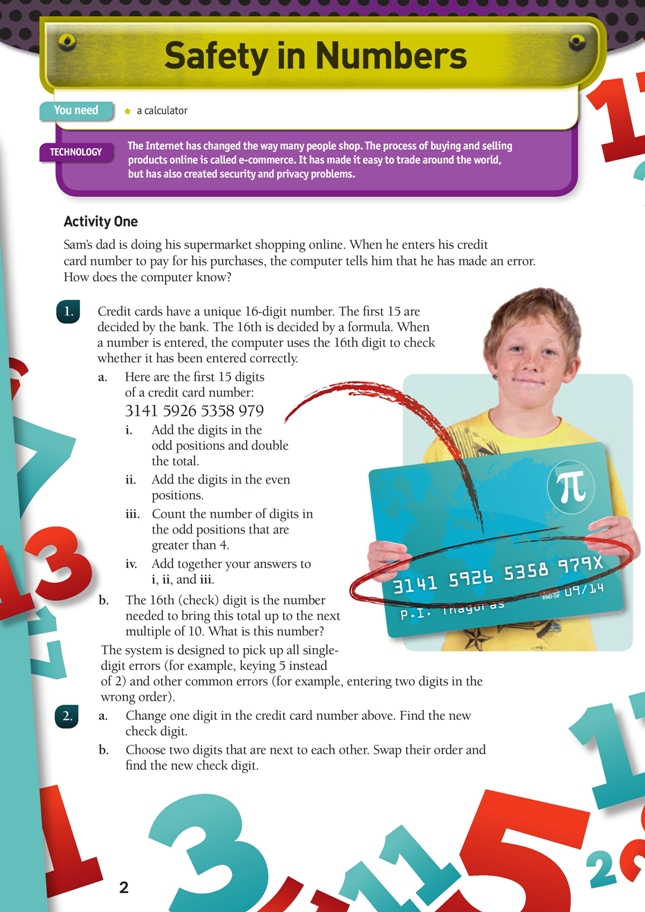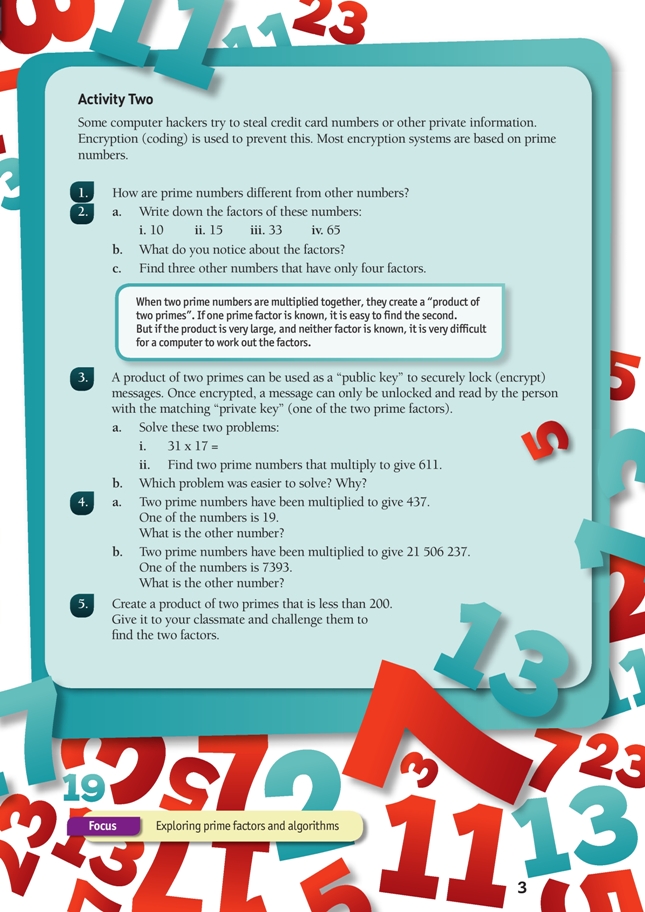This is a level 4-5 activity from the Figure It Out series.
A PDF of the student activity is included.
Click on the image to enlarge it. Click again to close. Download PDF (1581 KB)
Number theory is a branch of mathematics that explores the properties of numbers. Examples of properties of numbers include whether the number is odd, even, a square number, a multiple of another number, or a prime.
Number theorists have played an important role in developing systems to protect the security of online transactions.
In these activities, students see how properties of numbers can be used to create encryption keys.
FIO, Technology in Practice, Levels 3+-4+, Safety in Numbers, pages 2 - 3
In these activities, students investigate credit card security using number strategies, prime numbers, and factors.
Begin by discussing “properties of numbers”. For example, 10 is positive, even, and divisible by 1, 2, 5, and 10. 3 is odd, positive, and a prime.
Activity One
In this activity, students use an algorithm, which is a series of instructions used in mathematical applications, to complete a task or problem. Students can work in small groups or individually.
Barcodes use a different algorithm. The 13th digit used on book barcodes is the check digit. Here is how it is calculated:
The 12 products are added (132). The 13th (check) digit is the number needed to bring this total up to the next multiple of 10. (132 + 8 = 140, so the check digit is 8).
Note that this algorithm can also be described as follows: find the sum of the digits in the even positions and multiply by 3. Add on the sum of the odd digits. Divide the result by 10 and subtract the remainder from 10 to get the check digit.
It is satisfying to know the “trick” that is used to work out a check digit. Encourage students to verify these algorithms using an actual credit card and a book barcode.
Activity Two
As this activity demonstrates, primes are remarkably hard to find when buried in a large number, particularly when the large number is the product of two primes. This elusiveness gives them a strange power – a power that has led to their harnessing for cryptography purposes.
For numbers of 100 and less, the Sieve of Eratosthenes can be used to identify prime numbers. This sieve is available at https://nzmaths.co.nz/resource/sieve-eratosthenes. If your students have not come across this tool before, it will provide a good introduction to this second activity.
As they do question 3, students will discover for themselves that while they can easily multiply two primes on a calculator, it is an entirely different matter to be given the product of two primes and have to find its factors. The bigger the product, the harder the task.
Like primes, cryptography is a fascinating subject. Briefly, the most common type of cryptography used for web-based transactions is “public key – private key” cryptography. The public key is made available to anyone who may need it and is used to encrypt a message before sending it. The matching private key is in the hands of the individual or organisation for whose eyes the message is intended and is used to decrypt (unscramble) the message.
One analogy is a locked letterbox. Anyone can drop a letter into the box (the “public key”) because it is in a public location (at the gate), but only the owner can unlock it (because only they have the “private key”) and retrieve and read the letter.
A second analogy concerns two people, Alex and Brenda. If Brenda wants Alex to send her a secure message, she sends him a box and an unlocked padlock (the “public key”). Alex puts the message in the box, snaps the padlock shut, and couriers it to Brenda. Because only Brenda has the matching key (the “private key”), only she can open the box and read the message.
The credit card activity is based on a similar activity from the NRICH website (http://nrich.org/public). The site provides a wide range of rich tasks and mathematical explorations.
For another Figure It Out activity involving prime factors, see Nifty Networks, found in the level 3+–4+ Technology Transformations book (pages 6–7).
Technology-related student activities
- Research the history of locks and other security systems.
- Research common passwords and discuss why it is not a good idea to use such words.
Exploring the technology-related context
Security of online transactions is a major issue for e-commerce. People need to protect their finances, intellectual property, and privacy from criminals who have access to increasingly sophisticated software. One way to thwart hackers is to encrypt electronic data.
A more traditional security device is the use of a password or passcode. Strong passwords are typically a combination of numerals and letters and do not resemble actual words.
Passwords are often required to access emails, networks, files, databases, websites, blogs, and bank accounts. Added to these are passcodes for ATM, mobile phones, and access to buildings. Remembering all these passwords and passcodes can be problematic.
Answers
Activity One
1. a. i. 84. (42 x 2)
ii. 35
iii. 5
iv. 124
b. 6. (124 + 6 = 130)
2. a. Answers will vary depending on the number changed.
b. Answers will vary depending on the numbers swapped.
Activity Two
1. A prime number has exactly 2 factors (1 and itself).
2. a. i. 1, 2, 5, 10
ii. 1, 3, 5, 15
iii. 1, 3, 11, 33
iv. 1, 5, 13, 65
b. Each number has 4 factors, 2 of which are primes.
c. Answers will vary. Possible answers include: 6, 14, 21, and 55.
3. a. i. 527
ii. 13 and 47
b. The first one is easier – you only have to do the multiplication on a calculator. In the second problem, you need to investigate lots of possibilities to find the answer.
4. a. 437 ÷ 19 = 23
b. 2 909
5. Practical activity

